Arundo Update- June 2023
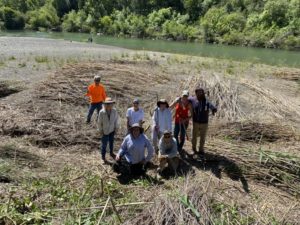
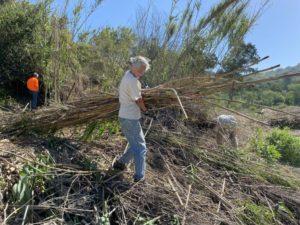
Here’s the latest update on Riverkeeper’s ongoing Healdsburg Arundo Removal Project:
Our crews and volunteer groups have been working hard on eight properties and have removed approximately four acres of invasive Giant Reed, Arundo donax, from various private parcels along the Fitch Mountain area. The work has been funded by generous Riverkeeper donors and we are so thankful for those funds used to break ground on this project. We appreciate the help of volunteers from the Healdsburg Rotary Sunrise Club and the high school Interact Club when we removed lots of Arundo from the Badger Park river access beach. We also received volunteer work sessions with the Fitch Mountain Association and residents of the area that care deeply about the river’s health. Giant Reed is an extreme fire hazard and water guzzler. Once the invasive plant is removed, it opens up the riverbanks for native plants to establish, and we love seeing little willows, cottonwoods, mugwort, Dutchman’s pipevine, oaks, walnuts, bay laurel, and other riparian trees and plants in our work area that will greatly benefit from the widened opportunity for growth. The regrowth of Arundo is vigorous with all the rains that we had this year, so careful treatment with environmentally safe herbicide will be necessary to eradicate it for good. Riverkeeper is taking all the steps necessary to comply with safety procedures to ensure that our crew, the river, its native flora and fauna, the residents, and their pets are all unaffected by the herbicide treatment. The Project gained significant traction with the June 1 vote by the State of California Coastal Conservancy to approve funding for this project for years to come. Our goal with the new funding is to be able to do a thorough job of removing Arundo, which will likely require many repeated treatments of this persistent Giant Reed over the next few years.
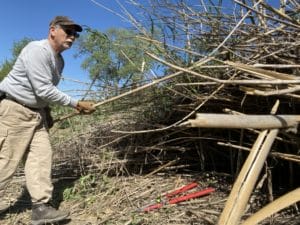
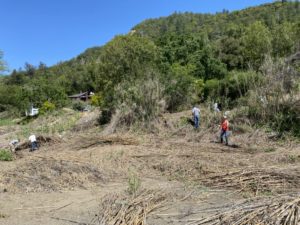
Arundo Update- March 2023

We are excited to report great progress on the Healdsburg Arundo Removal Project. The second property we worked on in February had a massive stand of Arundo that was tangled with grape and wisteria vines, making it a difficult task. Ivan and Birkin steadily chipped away at the tangled grape and wisteria vines, removing the cut canes at ground level and then hauled them away to be chipped into mulch. We gained a helpful boost in progress from community volunteer workers thanks to the Fitch Mountain Association. Thank you for your donations that help our crew continue work on the Arundo removal project.


Arundo Update – November 2022
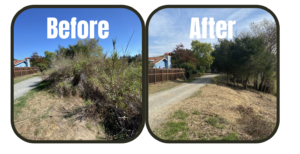
In October, we continued to work with the amazing Resilience Task Force crew to remove a half mile of highly flammable Arundo donax in Healdsburg. We were able to launch the Arundo removal project in partnership with Healdsburg Fire because of our donors.
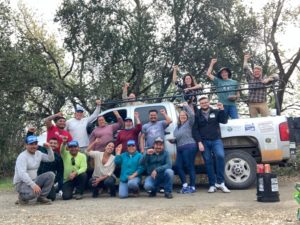 Healdsburg Fire Marshall, Lance MacDonald, identified the river bank area upstream of Badger Park as the highest priority for work that occurred over three weeks. In this area, the “birds” subdivision backs up against the river where Arundo grows in dense stands posing a fire risk. This work is part of the Healdsburg Area Fuels Reduction Project is permitted by CalFire and other state agencies and covers five miles of the river corridor. This work will continue for the next three years to ensure Arundo is fully eradicated.
Healdsburg Fire Marshall, Lance MacDonald, identified the river bank area upstream of Badger Park as the highest priority for work that occurred over three weeks. In this area, the “birds” subdivision backs up against the river where Arundo grows in dense stands posing a fire risk. This work is part of the Healdsburg Area Fuels Reduction Project is permitted by CalFire and other state agencies and covers five miles of the river corridor. This work will continue for the next three years to ensure Arundo is fully eradicated.
Our incredible Restoration Director, Birkin Newell, led the crew to remove highly invasive Arundo while preserving all native riparian plants. Crews used chainsaws, loppers, machetes, and hedge trimmers to cut down the Arundo on the steep banks. Thanks to a generous grant from the Healdsburg Rotary Club, we were able to buy four new Stihl electric chainsaws and hedge trimmers. These powerful battery-powered tools made quick work of the tough, bamboo-like canes as we cut them nearly flush to the ground. The Healdsburg Rotary club’s goal is to support our work and reduce climate impacts by shifting to battery-powered gear and the crew appreciated not having to breathe exhaust fumes. Arundo was piled for later chipping and then spread on the floodplain area where it can dry and no longer be viable to grow. Chipping helps return the carbon from removed vegetation back into the soil and also helps to reduce the new growth of weedy vegetation.
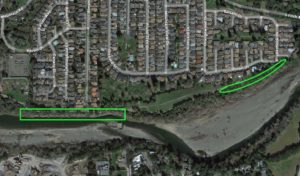
Removing the Arundo canes is the first step of several to successfully eradicate the Arundo which still has rhizomes that will re-sprout. In several weeks crews will return to cut re-sprouts and paint them with a low-toxicity herbicide. Leaving the rhizomes on the steep banks protects the soil from erosion in the coming winter rains. Ultimately native plants will be allowed to recover in the area now that the competition from Arundo is suppressed.
Thank you to our donors for your support! Your support allowed us to start work this year. In the next six months, we’ll be working to fully fund the entire five-mile project which will likely take three years to complete. Once complete, the project will reduce fire risk, keep more water in the river and improve the river ecosystem!
For the month of August, Russian Riverkeeper teamed up with North Bay Jobs with Justice (NBJJ) and Resilience Force to create and train a new Climate Resilience Task Force. This exciting collaboration brought together two Riverkeeper field restoration experts, Birkin and Ivan, with ten Indigenous and immigrant farm workers from Oaxaca, Mexico. 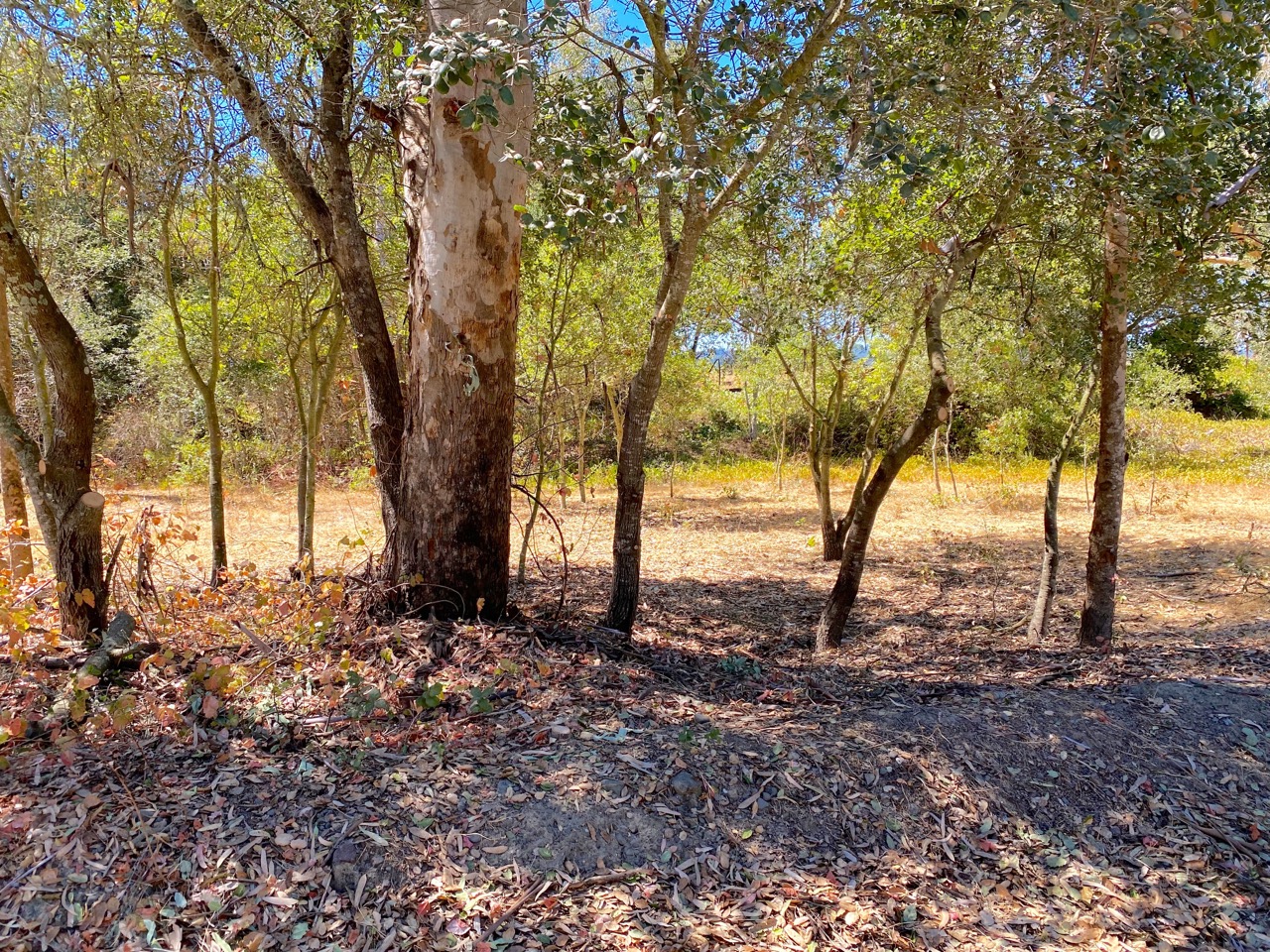
Riverkeeper executive director Don, has envisioned developing a workforce of skilled, hard-working immigrant farm workers that could help us occasionally on our habitat restoration, fire recovery, and other environmental projects. The goal was to pay them a fair living wage, provide training and support, and create a labor force that can be hired for future projects by organizations doing climate resilience projects. The Resilience Force model was created after Hurricane Katrina in New Orleans in an effort to represent migrant workers that were often taken advantage of by federal disaster recovery contractors.
This goal came to fruition with the NBJJ collaboration and some County funding from Supervisors Lynda Hopkins and James Gore to create and train such a force. This vision then became a reality. On August 1st, we began working along the Russian River at Geyserville Bridge, which has a lot of recreational use and campfires. At this site, heavy weeds and overgrown vegetation at ground level had created a dangerous “fuel ladder” effect. Fuel ladders are where a single ignition source on the ground could rapidly escalate a fire from the grasses on the ground, through low shrubs with dead branches, and up into the tree canopy.
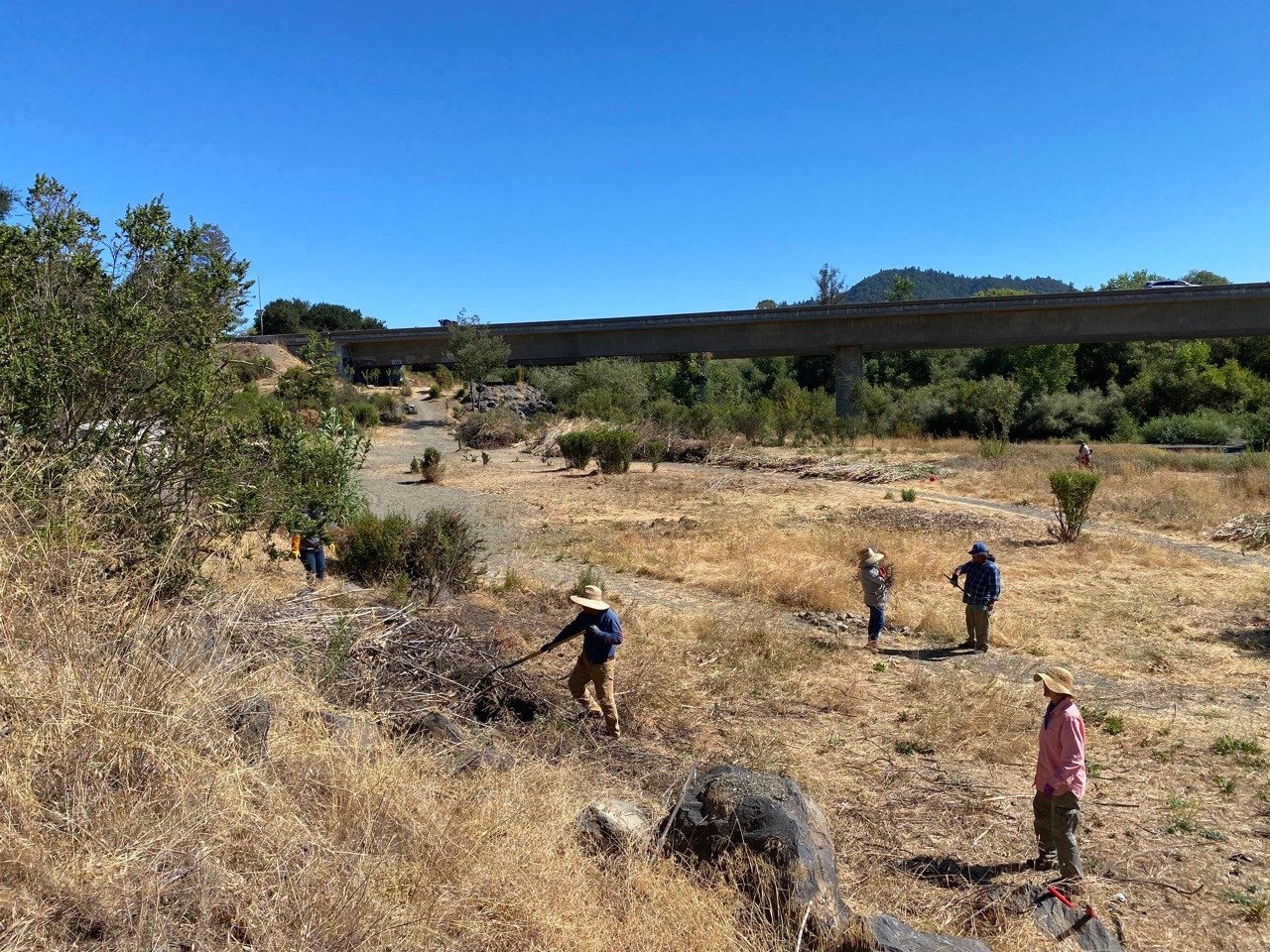
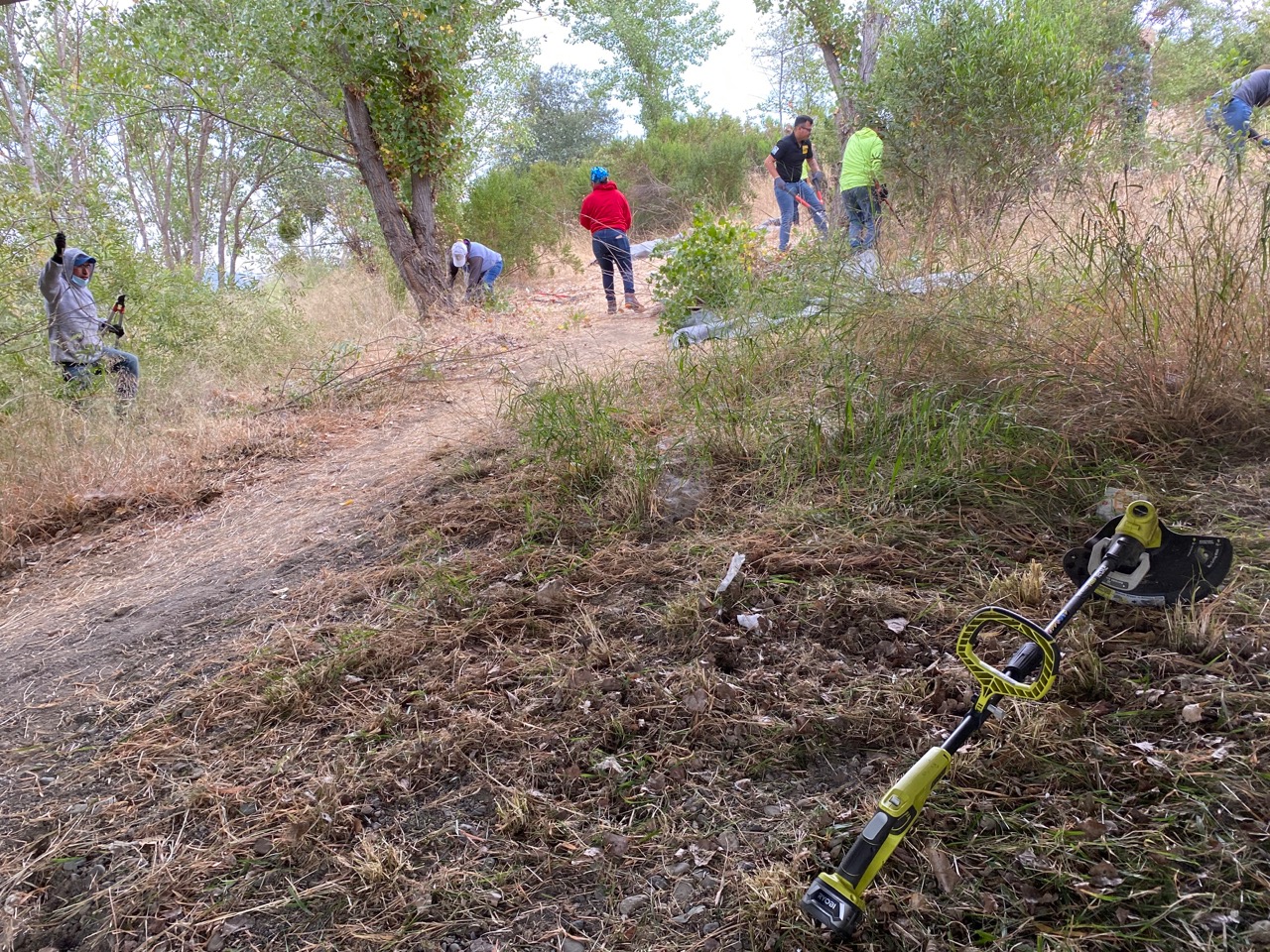
Breaking up the fuel ladder by cutting away dead limbs, lifting shrubs off the ground, and weed-whacking grasses can effectively slow down the spread of a wildfire and help to protect nearby communities and infrastructure. The ultimate result is known as a shaded fuel break where the remaining tree canopy helps reduce the re-growth of low-growing vegetation. Once our goal was explained to the crew, the knowledge and vast experience of the workers became immediately evident, and this made for quick and efficient work. Soon, we were chipping up all the cut material, spreading it out, cleaning up all the trash, and moving on to our second site, along the River in Healdsburg below the 101 bridge. The heat became an issue, and we collectively agreed that we would not have to labor in temperatures over 95 degrees in full sun, for our safety. North Bay Jobs with Justice is all about farm workers’ rights, and many stories were shared about past experiences working in dangerous heat and how we can avoid problems in the future. We focused instead on discussing local ecology, learning about native plants to not cut down, and had a very nice cultural exchange, all while sitting in a talking circle under the shade of a big oak. Respect, care, and appreciation were in full effect.

The second half of August we were able to complete the Healdsburg 101 bridge area, which was a massive undertaking. We also took a day to clean up vegetation in Guerneville along the River, and finished up strong in Cazadero. Everywhere we worked, the locals we encountered were very appreciative of the work the crew was doing. It was such a special experience for our staff and we’re looking forward to working with the crew again. Look for updates as we hope to utilize the Resilience Force Climate Task Force to remove Arundo from the Russian River in October.
We are able to work with our community partners on great projects such as the Arundo Project and many more because of your contributions and support! Donations can be accepted here.
